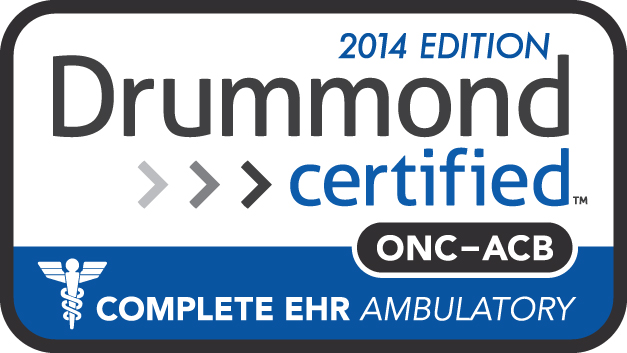

This complete EHR certification is 2014 Edition compliant and has been certified by an ONC-ACB in accordance with the applicable certification criteria adopted by the Secretary of the U.S. Department of Health and Human Services. This certification does not represent an endorsement by the U.S. Department of Health and Human Services or guarantee the receipt of incentive payments. Drummond Group is accredited by ANSI and approved by ONC for the ONC HIT Certification Program to certify: Complete EHR, EHR Module (all), and Certification of other types of HIT for which the Secretary has adopted certification criteria under Subpart C of 45 CFR
Stat! Electronic Medical Management version 2.0 was certified for both Inpatient and Ambulatory 2014 Edition on April 7, 2014.
Stat! Electronic Medical Management version 2.0 Complete EHR Inpatient Complete EHR Inpatient Certificate Number: 04072014-2006-5 Modules Tested: 170.314(a)(1-17); 170.314(b)(1-7); 170.314(c)(1-3); 170.314(d)(1-8); 170.314(e)(1); 170.314(f)(1-4); 170.314(g)(2-4) Clinical Quality Measures Tested: CMS026v1; CMS030v3; CMS032v3; CMS053v2; CMS055v2; CMS060v2; CMS071v3; CMS072v2; CMS091v3; CMS100v2; CMS102v2; CMS104v2; CMS105v2; CMS107v2; CMS109v2; CMS110v2; CMS111v2; CMS114v2 Additional Software Used: EMR Direct phiMail Server, Microsoft HealthVault
Stat! Electronic Medical Management version 2.0 Complete EHR Ambulatory Complete EHR Ambulatory Certificate Number: 04072014-2007-5 Modules Tested: 170.314(a)(1-15); 170.314(b)(1-5,7); 170.314(c)(1-3); 170.314(d)(1-8); 170.314(e)(1-3); 170.314(f)(1-3); 170.314(g)(2-4) Clinical Quality Measures Tested: CMS062v2; CMS065v3; CMS068v3; CMS117v2; CMS122v2; CMS123v2; CMS124v2; CMS125v2; CMS126v2; CMS127v2; CMS131v2; CMS138v2; CMS139v2; CMS146v2; CMS148v2; CMS154v2; CMS155v2; CMS156v2; CMS165v2; CMS166v3 Additional Software Used: EMR Direct phiMail Server, Microsoft HealthVault
Costs and Limitation Statement:
- The Stat! Enterprise Medical Management Version 2.0 application and associated supporting applications require a monthly support fee per organization which includes software updates, Multum National Drug Database download access, and clinical staff support.
- The Stat! Enterprise Medical Management Version 2.0 application requires an annual subscription fee, per organization, for Direct Messaging services and Transitions of Care Summaries (health information exchange). Messages sent outside the product’s HISP network of EMR Direct may require fees per transaction.
- Laboratory Interface Systems and Radiology Viewing Systems are not included in package pricing. MedWorxs has several recommended vendors but will work with other vendors and one-time interface costs may be applicable for each system.
- The Stat! Enterprise Medical Management Version 2.0 application may require one-time costs to establish each interface for transmission and reporting to regional health exchanges, immunization registries, cancer registries and public health agencies.
- Support for integration with other ONC certified systems or existing facility resources, such as medication dispensing systems, dictation systems, or patient monitoring devices may require additional fees or costs.
Technical or Practical Limitations:
- Hardware, software, network and wireless capability are not included in package pricing and can vary based on facility requirements. Hardware List and Use is detailed below.
STAT! Enterprise Medical Management Software
Recommended Hardware List and Use
This list constitutes the most used and recommended hardware for use with the STAT! EMM system. This list is not all inclusive. Please contact MedWorxs if you will be using different models or vendors for your hardware needs so that the equipment can be verified prior to ordering of the product.
Document Printing:
NOTE: Printers must be network-capable and be PCL compatible. It usually saves money in the long run to buy workgroup-class laser printers over desktop or personal laser printers. Inkjet printers not recommended becase of the cost of ink. We recommend HP printers but other brands are supported.
Document Scanners:
Some individual document scanners may be utilized for single page scanning as well as ID card scanners. Single document scanning can be done through the use of the Multifunction printing/scanning device as listed above, but single page scanners could be used in places where space is limited or full functionality of a multifunction device is not needed.
Barcode and Label Printers:
Zebra Printers are widely used and trusted in the barcode labeling arena.
Barcode Scanners:
For Clinical and Non-Clinical Use
ID Automation 2D (and 1D) barcode scanners (actually made by Honeywell) Model # SC7-USB-2D. Honeywell equivalent versions can be used but there are many variants and some work better then others.Signature Pads:
The use of signature pads should be determined on whether or not the facility will employ touch screen tablets within the facility. Signature pads would be needed by any pc computer (non-touch screen) where patient signatures are required. Typically the uses for signature pads are at registration areas and possibly ER areas where patients would sign registration forms, consent forms and discharge forms.PC Computers:
Workstation PC's:These PC's are typically used in environments where stationary work PC's can be placed and mobile computing is not needed. Workstations provide a more robust processing power in most cases for other business needs besides electronic medical records software. The following is a list of MINIMUM hardware requirements for PC's.
NOTE: All in one PC's are recommended for areas such as nursing stations or Emergency areas. They take less space and most are touch screen compatible with larger sized screens. If your facility wishes to use this type of PC, we recommend HP All In one Touch Screens with system minimum requirements specified above.
Recommended ALL-IN-ONE PC's:
HP TouchSmart line. Tested against the 7320.Mobile Tablets and Laptops:
Wireless Access:
High bandwidth, overlapping coverage and rollover of coverage from access point to access point is essential to the success of wireless in the clinical setting. Wireless connectins are, by their nature, always going to be less reliable than wired connections. We recommend using wired connection as much as possible. Do not use nome or consumer-grade wireless products. While we cannot recommend a specific wireless configuration or hardware devices to be implemented within your facility, other clients have had very good success with the following:
Hardware Recommendation Note: Infection control issues within the clinical setting should always be a consideration for any hardware device. For example: Monitor covers or screen overlays that can be cleaned should be considered when implementing touch screen devices whenever possible.
© 2015 MedWorxs LLC. All rights reserved.